It’s a warm day in early June, and researcher Nicholas Dietschler is standing in front of an eastern hemlock sapling about a quarter of a mile up a steep ridge in New York’s Catskill Mountains. The evergreen is not looking good. Its lower branches are brittle and dead. Its upper limbs are balding. Dietschler visually scans the tree’s stubby needles. It doesn’t take long for him to find what he’s looking for. Tiny, woolly white bumps the size of sesame seeds coat the sapling’s spindly branches. Dietschler runs his thumb along the bumps. “Blood,” he says, holding up a finger streaked with orange. “They’re alive.”
A blue cooler lies open on the ground, filled to the brim with neatly stacked plastic vials. “I just signed up to spend the next five years of my life working on this,” Dietschler says, looking at the cooler. The hemlock Dietschler is standing in front of will probably be dead before those five years are up, as will many more hemlocks throughout the northeastern United States.
The tiny bumps are the egg sacs of a destructive insect called the woolly adelgid, which caught a ride with Japanese goods bound for America in the early 20th century and has been wreaking havoc on the nation’s Eastern forests ever since. The aphid-like insects suck the sap out of hemlock needles, killing the trees where they stand. The bugs are all female and can reproduce asexually, which makes them a formidable enemy to begin with. But climate change is assisting woolly adelgid in its quest for total domination of the Northeast’s hemlocks by helping it spread north into colder climes. It’s already rampaged through the southern Appalachian mountains, leaving a trail of millions of devastated hemlocks on its way North. If adelgid continues to proliferate unchecked, hemlocks could disappear entirely from the Northeast.
The survival of species hangs by a thread, and the outcome could depend on the contents of the blue cooler.
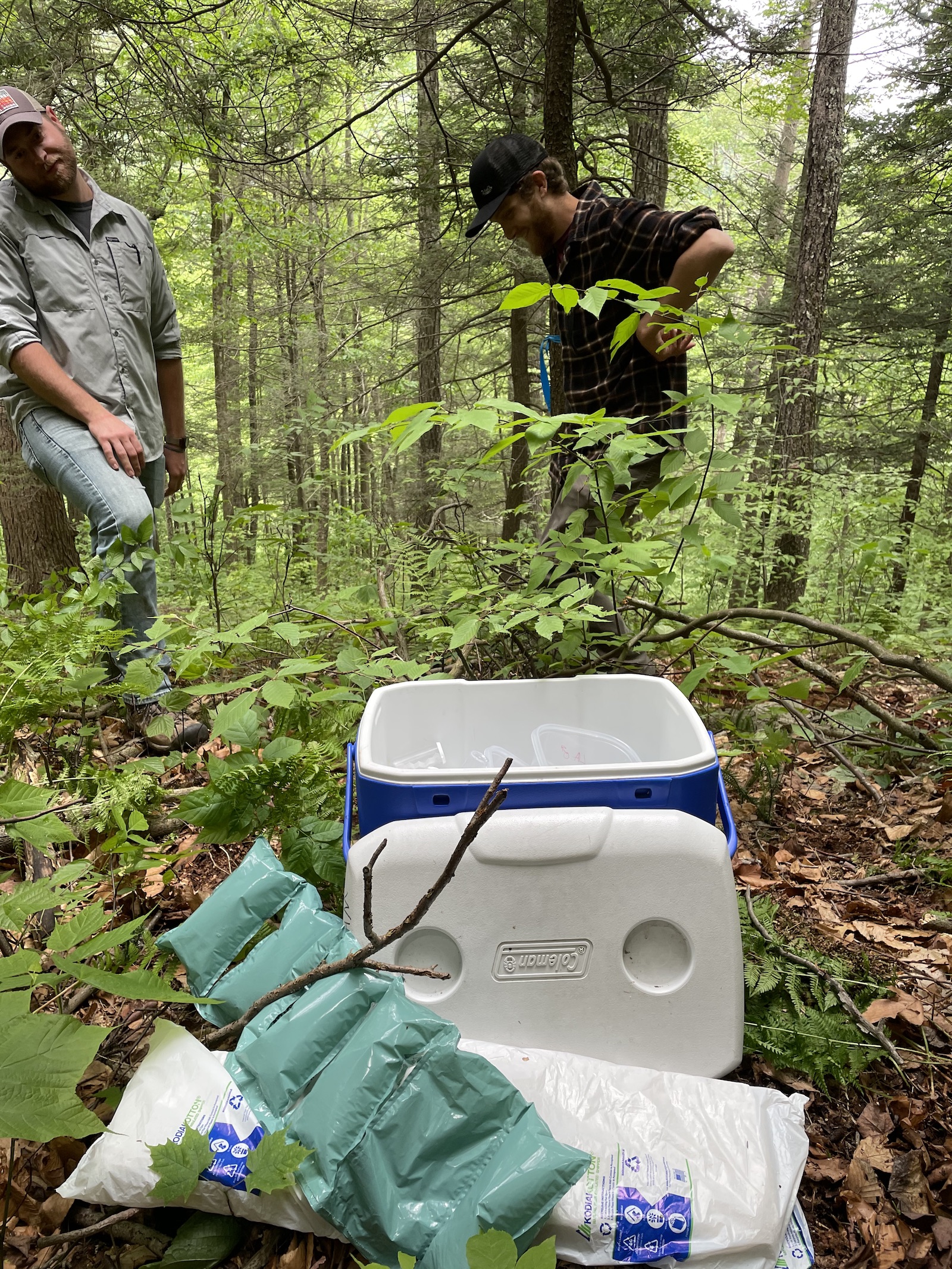
Invasive species are difficult to contain in the absence of climate change. But they’ve become especially tricky to stop as winters have grown warmer and more of the nation has become temperate, allowing these pests to explore previously impenetrable territory. As a result, invasive tree bugs and blights are on the rise across the United States. Hundreds of thousands of elms are being taken out by the Dutch elm disease, spread by the voracious elm bark beetle. Butternut canker disease has infected the white walnut. Beeches are falling ill with beech bark and beech leaf disease. An iridescent green beetle called the emerald ash borer has lain waste to ash trees. Sudden oak death, a pathogen, is coming for oak trees. And hemlocks are succumbing to woolly adelgid.
The U.S. can’t afford to lose its trees. The nation’s existing forests absorb 9 percent of its carbon emissions by turning carbon dioxide and water into wood via photosynthesis. When trees die, that process is reversed, and the carbon dioxide stored in the wood is slowly released into the atmosphere. Just 15 nonnative pests, including woolly adelgid, threaten to destroy upward of 40 percent of those forests. Already, the biomass lost to invasives every year releases emissions similar in magnitude to the emissions produced by trees killed in wildfires — the carbon equivalent of the tailpipe emissions produced by 5 million cars on the road each year.
Meanwhile, “natural” solutions to climate change — using landscapes to sequester carbon dioxide — are growing more popular. Governments around the world, including the United States, are pouring millions of dollars into planting trees. In the U.S., members of Congress want to plant 100 billion new trees. But their plans don’t take exotic species into account. It’s not a given that these new trees, or the trees already in the ground, will be able to withstand the rising tide of invasive pests. If the pressures of climate change force the nation’s trees to start emitting carbon dioxide instead of sequestering it, our Hail Mary climate solution may become part of the problem.

The individual hemlock that Dietschler, the researcher, is standing in front of is likely doomed. But at the very top of the ridge, a grove of pristine, old-growth hemlocks grow straight and healthy out of the forest floor. Their canopies are thick and bushy, untouched by saws or pests for hundreds of years. The difference between these hemlocks and the tattered trees downslope is stark. Stepping into the healthy grove feels like entering a cathedral. It’s quiet, dark, and cool, even on a summer day.
“The reason we’re releasing here is because of that stand up there,” Dietschler says, looking uphill. What he’s releasing rests inside of that blue cooler: a little more than 1,000 live silver flies. If all goes according to plan, the flies will feast on the woolly adelgid in the infested trees, arresting the spread of the invasive insect and protecting the healthy hemlocks at the top of the ridge. The battle between adelgid and fly is a preview of future fights to curtail invasive species. Nonnative pests are difficult to contain in normal climatic conditions. Can scientists save the nation’s trees from invasives supercharged by climate change? The Northeast stands to lose a great deal if they can’t.
In the early 1900s, ships carrying plants laden with woolly adelgid arrived in America from southern Japan. It didn’t take long for adelgid to establish a foothold on the continent, but it wasn’t discovered until the 1950s, in Virginia. Soon after that, adelgid was found in more states. The bugs moved fast, sucking the juice out of hemlock needles and killing trees up and down the Eastern seaboard — young, old, big, and small — in as little as four years. They hopped the Long Island Sound in the 1980s and invaded the Catskill Mountains a decade or so after that. For a time, the pest’s range was capped by the Northeast’s cold winter temperatures. Adelgid can’t withstand temperatures below freezing for very long. But warming winters have made the Northeast, where there are large sections of uninterrupted hemlock forest, more inviting to invasive species. Now, woolly adelgid is everywhere. More than half of America’s Eastern forests are infested with it — almost every state in the Eastern Seaboard.
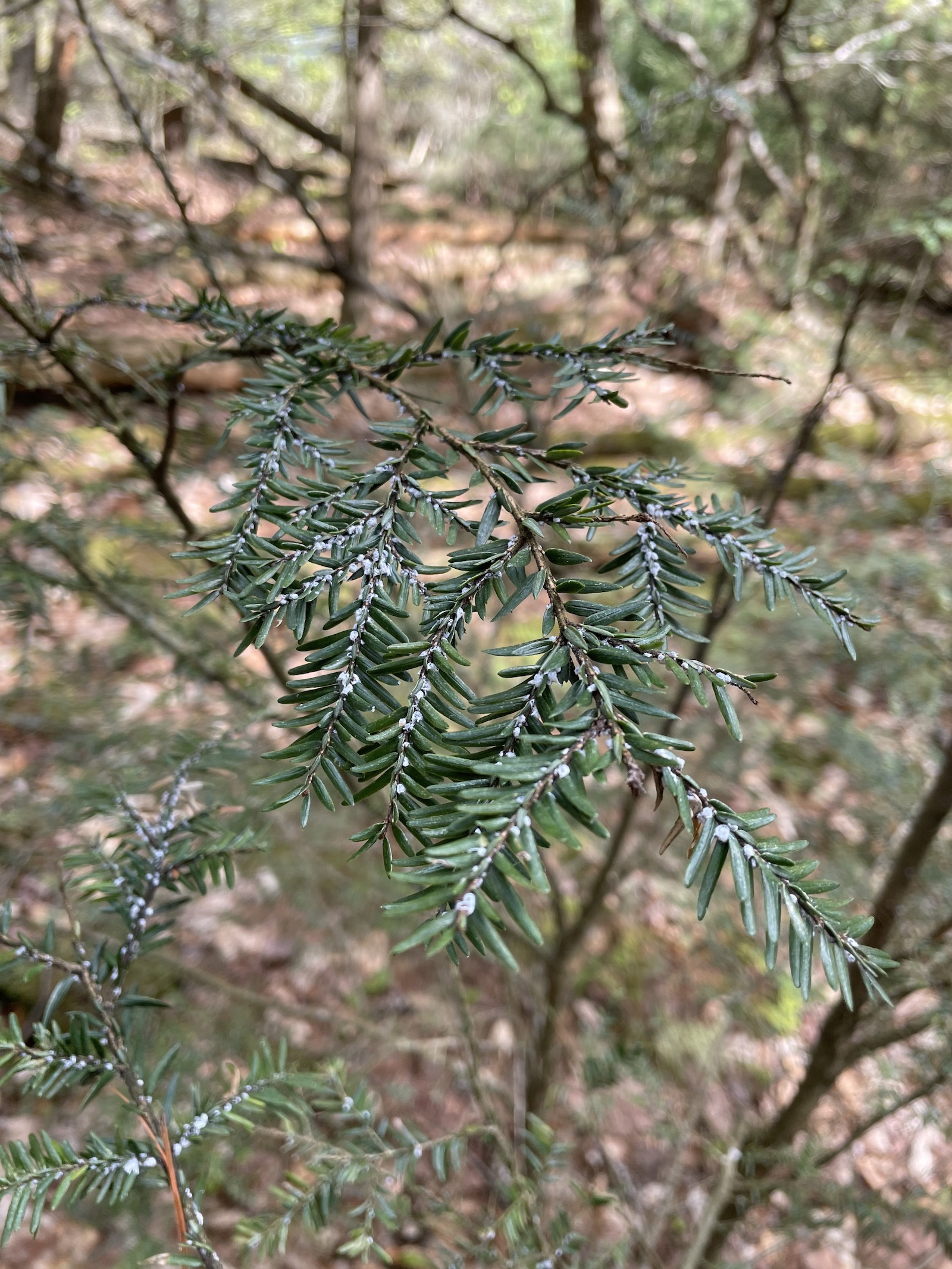
“It’s basically killed untold millions of trees on the East Coast,” said Mark Whitmore, head of the New York State Hemlock Initiative, a state-funded lab housed at Cornell University that works in concert with the Department of Environmental Conservation. The Hemlock Initiative also employs Dietschler and organizes the release of the adelgid-eating flies. “It’s like one of those wild sci-fi-like scenarios, but it’s right there on our doorstep. With warmer winter temperatures, the problem is just going to get worse.”
That’s exactly what happened last winter. Warm winter temperatures contributed to extremely low mortality rates among adelgid populations across much of the East Coast. That led to an explosion of pests this summer. “They are everywhere in high abundance,” David Orwig, a senior ecologist at the Harvard Forest, a 4,000-acre research area in Petersham, Massachusetts, managed by Harvard University, told Grist. “The warming winters exacerbate the problem. No question.”
If the U.S. can’t afford to lose its trees, the Northeast really can’t afford to lose its hemlocks. “No other tree species in our eastern landscape exerts such a widespread and profound influence on the environment and other organisms, including ourselves,” researchers who work in the Harvard Forest, Orwig among them, wrote in a book published in 2014 titled Hemlock: A Forest Giant on the Edge. Losing the hemlock, the book says, is like “losing a conductor and the music.”
Deciduous forests are made up of many different kinds of trees that lose their leaves every winter — oak, birch, ash, maple, poplar. When an ash tree disappears from a deciduous forest — because it’s been killed off by an emerald ash borer, perhaps — other leafy trees crowd out the carnage. Hemlock forests are dominated by one type of tree. They grow in massive, undulating stands of homogenous green that are vibrant 365 days a year. When the hemlock disappears from a hemlock forest, not much is left behind.
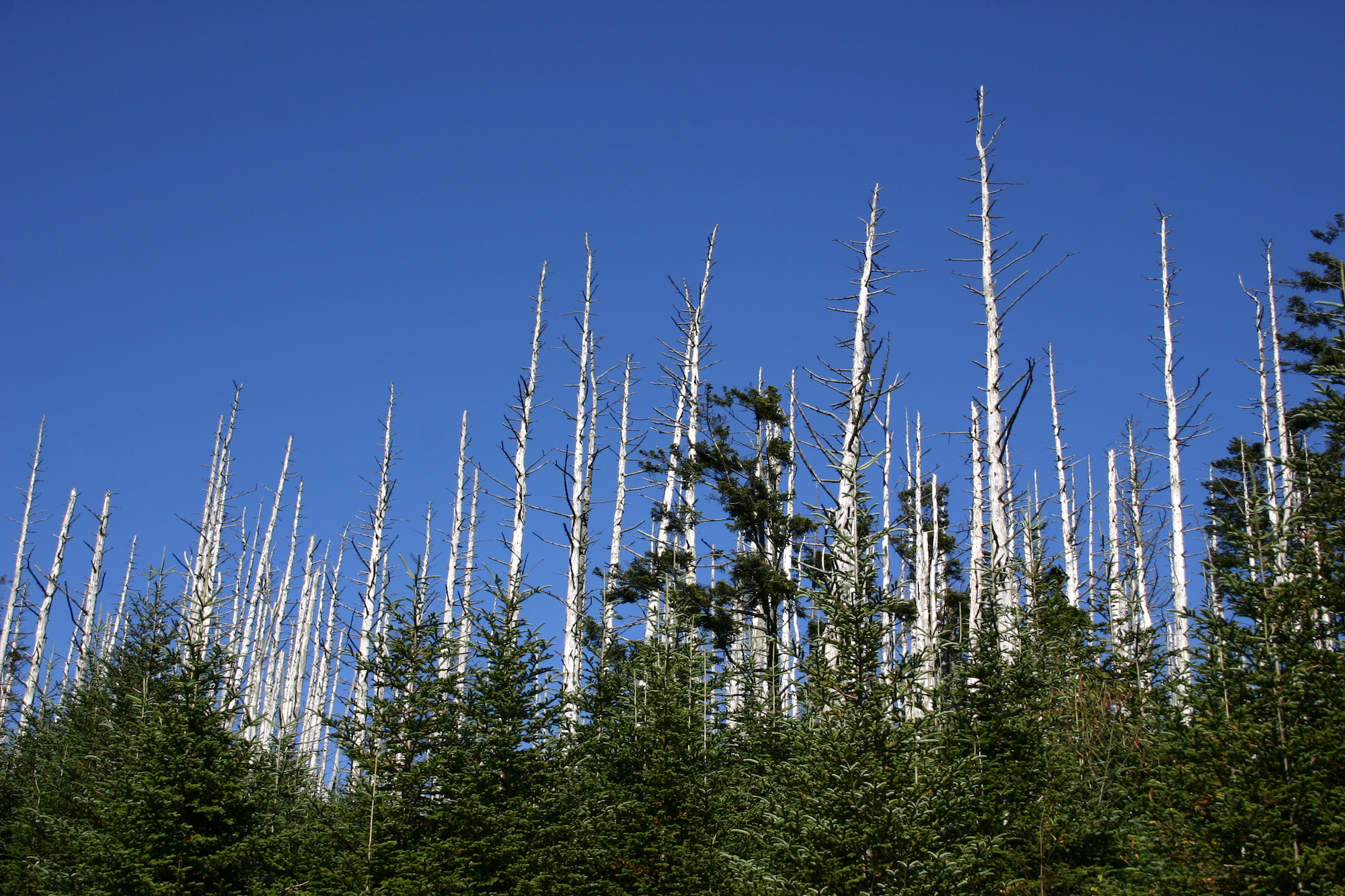
Hemlocks are a foundation species, meaning they play a pivotal role in structuring ecological communities. Their greatest contribution is the deep shade that they create. Just 1 percent of the sunlight that hits a hemlock canopy manages to reach the forest floor. The trees’ feathered branches slope down to the ground instead of up toward the light, creating a muffled dome. Temperatures beneath this green tent can be as much as 10 degrees Fahrenheit colder than the outside world at the top of the tree and another 5 to 10 degrees F colder at its base.
In the winter, the tent keeps snow off the ground. Deer gather in the circumference of the hemlock boughs, safe from the deep snow that accumulates beneath leafless deciduous trees. Ruffed grouse and barred owls nest in hemlock’s upper canopies. Snowshoe hares nibble on its green branches. Porcupines gnaw on its tannin-rich bark. In the spring, as the sun beams down and melts snow and ice elsewhere, hemlock preserve circles of snow at their trunks, which leech slowly into nearby streams and creeks and keeps them cool. Brook trout depend on these cooling infusions of icy water, as do many species of salamander, frog, toad, and fly.
Humans do, too, even if they don’t know it. Hemlocks use water more conservatively than hardwood species of tree because their dense branches create moist and cool microclimates. “If you have hemlocks along streams that are replaced by hardwood that use more water, you do have the potential for drying streams, at least in the summertime,” Orwig, the Harvard Forest ecologist, said. Those streams are used for swimming, fishing, and recreation — a major part of the Northeast’s regional identity. And no matter where they grow, hemlocks provide financial and aesthetic benefits that humans enjoy. A study that looked at hemlock decline in central Connecticut and Massachusetts over the course of five years in nine counties found an accompanying decline in property values of $105 million.
“Most people just look at hemlocks as this green thing,” Whitmore, from Cornell, said. “But then you drill in further and then you see all kinds of really important ecosystem functions associated with the cooling and the climate they create.”
And hemlocks aren’t just good for the critters and humans who live nearby. They’re also very good at trapping carbon dioxide.
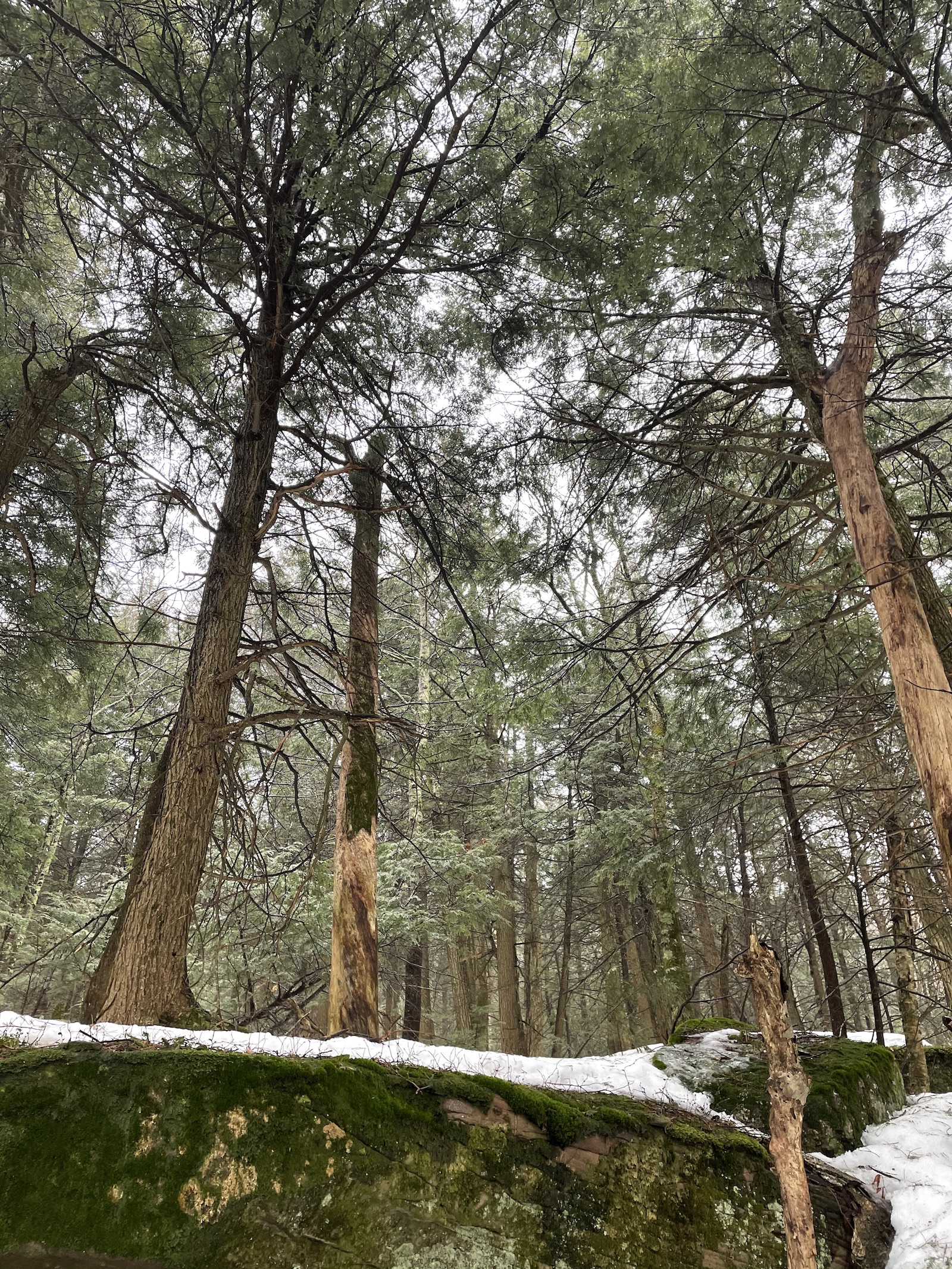
Hemlocks can sequester approximately 12 metric tons of carbon dioxide per two and a half acres, according to a 2002 study that compared the hemlock to other tree species. That’s more CO2 than the oak trees and ponderosa pines the study analyzed. But woolly adelgid could transform hemlocks from carbon sinks into carbon sources. That already happened in 2014 in the Harvard Forest. Researchers documented a hemlock stand that started producing carbon instead of sequestering it. “The forest can behave as a source of carbon with the loss of the hemlock,” Orwig, who helped document that shift from sink to source in a 2020 study, said.
A prior Harvard study showed that woolly adelgid could take an 8 percent bite out of northeastern forests’ carbon sequestering capabilities between 2000 and 2040. But that study and others predict that hardwood tree species, and an opportunistic tree called black birch in particular, will eventually replace the dead and dying hemlock — a trend researchers have already noticed in northeast woods. Past 2040, the Harvard study projects that those black birches will capture 12 percent more carbon than the hemlocks they replaced. But in the short term, that 8 percent decrease in carbon sequestration is a big deal, says Audrey Barker Plotkin, a senior scientist at the Harvard Forest who has spent years studying the impact of invasives on hemlocks.
“If we lose hemlock and there’s a reduction in carbon uptake for, say, 40 years, that’s exactly the time when we need to be doing everything possible to mitigate carbon loss,” she said. “That time frame is super important to having any chance of not losing the fight against climate change.”
And other scientists have questioned whether black birch would really be an improvement over hemlock when it comes to carbon storage. A 2018 study looking at trees and soil carbon found that 80- to 90-year-old hemlocks sequestered 6.8 times more soil carbon than black birches of the same age. That study estimated that woolly adelgid could potentially lead to a net release of 4.5 tons of carbon per roughly two and a half acres of hemlock forest replaced by black birch.
“Then if you think, wait, what if we lost all hemlocks? That gives you a ridiculously big number,” said Danielle Ignace, an assistant professor of ecology at the University of British Columbia and the lead author of the study on soil carbon. For now, the full extent of the carbon hole soon to be left by the disappearance of eastern hemlock is a big question mark. There is one major takeaway from Ignace’s research, however. “Our work is saying that it will take decades before we know the ramifications of losing the eastern hemlocks,” she said.
In the early 2000s, researchers had pinned their hopes of saving the eastern hemlock on a black beetle from the Pacific Northwest called laricobius nigrinus. Prior attempts to keep woolly adelgid at bay using predator beetles from East Asia had failed because they were difficult to breed and had a hard time surviving East Coast winters. The black beetle seemed hardier. The U.S. Forest Service was using limited funding to release thousands of them in forests in the South.
For a time, it seemed like it was working. The beetle laid its eggs in the woolly adelgid ovisacs, and when those eggs hatched, the larvae ate the woolly adelgid eggs. The larvae were able to eat upwards of 90 percent of the woolly adelgid. But, over time, it became clear that no matter how much adelgid the beetles ate, they couldn’t eat fast enough to outsmart the pest. That’s because woolly adelgid produces two generations per year: a winter generation and a spring generation. The beetle chewed through the winter generations, but the adelgid was able to rebound completely in the spring.
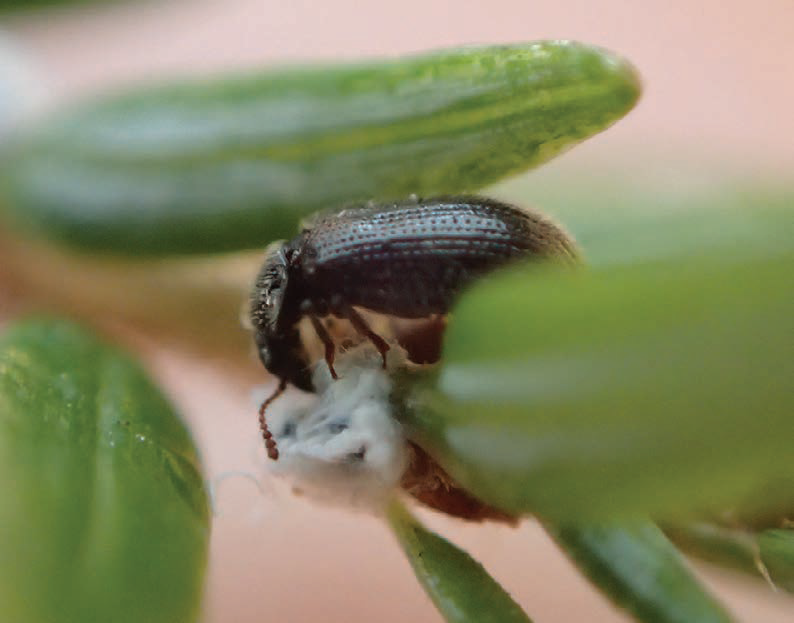
Something had to be done, but researchers and states were loath to admit that the black beetles, the biocontrol they had spent time and resources rearing and releasing, weren’t working. “This is not a field where people throw a lot of money at you,” Whitmore, who runs the New York State Hemlock Initiative, said. “Resources were thin.” Privately, Whitmore, who was also focused on black beetles at the time, had realized that they weren’t getting the job done.
Then, in 2014, Whitmore attended an annual invasive species meeting in Annapolis, Maryland. At that meeting, a man named Darrell Ross, a professor of entomology at Oregon State University at the time, stood up. He had conducted an analysis of all of the woolly adelgid predators in the Pacific Northwest, and he thought that the labs in attendance were missing something big: silver flies, the only other bugs in the Pacific Northwest other than the black beetle that researchers are sure only eat woolly adelgid. The flies had been overlooked for years because they’re difficult to trap and breed. But they’re just as common as black beetles on the West Coast, and, more importantly, they feed on the second crop of woolly adelgid, the spring generation.
“Darrell sort of got a bee in his bonnet,” Whitmore remembered. “He was wondering why everyone was so worked up about the laricobius beetle when we were ignoring the silver flies. It was an uncomfortable confrontation he had in the group, but he got my attention.”
After that meeting, Whitmore knew what he had to do. The key to saving the hemlocks might be releasing the silver flies and the black beetles together, so that they could attack both generations of adelgid. It would be another three years before Andrew Cuomo, the governor of New York, gave Whitmore the funding he needed to start his lab at Cornell. Once he did, Whitmore hit the ground running. “That’s what enabled me to really get going,” he said. In May 2017, his lab released its very first silver flies, just 740 of them, at four locations in New York over a period of three days. Whitmore remembers it as “a whirlwind adventure.” To date, Cornell has released 25,239 flies at 47 different sites.
It may be some time before researchers find evidence that the beetles and flies are keeping adelgid at bay. So far, the New York State Hemlock Initiative has documented evidence that the flies can survive year to year. But there’s not enough data to say for sure whether the flies are thriving and eating the spring generation of woolly adelgid in the wild yet. It may be years before Whitmore’s lab and the other, smaller scale initiatives to rear and release these predators know for sure if their efforts have paid off. Until then, states with eastern hemlock can spray and inject select trees with pesticides that kill off adelgid. That course of action, however, is expensive and doesn’t address the problem on a species-wide scale. The flies and beetles are the only potential long-term, cost-effective solution to the East’s growing pest problem.

Orwig, who has not been involved with the New York State Hemlock Initiative’s efforts, has been skeptical of the efficacy of biocontrols ever since researchers found evidence in the 1990s that the predators they were shipping in from East Asia weren’t surviving East Coast winters. But Orwig is cautiously optimistic that the silver flies can fill a crucial niche. “There’s a better chance for success,” he said. “I’m still hopeful that biocontrol can be helpful.”
But Orwig noted that the beetles and silver flies can only be effective as long as the funding exists to continue rearing and releasing them. “There’s limited resources,” he said.
For now, New York is being generous with its hemlock funding. In 2020, the state’s Department of Environmental Protection agreed to give the New York State Hemlock Initiative $1 million over five years. “We’re definitely concerned,” Bryan Ellis, a forester with the New York State Department of Environmental Conservation, told Grist. “We’re kind of like throwing the kitchen sink at this problem.”
But adelgid isn’t the only invasive threatening native flora in the state, which has earmarked more than $13 million for invasive prevention and control activities in its 2021 budget. The New York Department of Environmental Conservation is also battling multiple invasives: hunting down the spotted lanternfly, doing damage control on the emerald ash borer, keeping tabs on the Asian longhorned beetle, ripping out an insidious herb called giant hogweed. “You can’t focus on just one,” Ellis said. “We have a lot of priorities and we’re getting to them the best that we can.”
Researchers estimate biological invasions will increase by 20 to 30 percent by midcentury, in large part because of climate change. Those invasives, the study says, will cause major impacts to biodiversity around the world.
A biological invasion may be on the horizon, but on the ridge in the Catskill mountains, everything is peaceful and quiet. Birds rustle in the branches of a large, wizened hemlock. A soft breeze lifts the leaves on an oak tree. The Pantherkill Creek burbles in the valley below. Dietschler takes a vial out of the cooler and pops the lid. He turns it upside down over a branch on the sickly hemlock sapling and nudges the silver flies, lethargic after their three-hour trip from the lab at Cornell, free. The predators, each no bigger than a pinhead, come to their senses and zigzag out of the vial. In the blink of an eye, they’ve flitted away into the understory.
“I wouldn’t choose to waste my own personal time, passion, and effort on this,” Dietschler says softly, watching them go. “I truly believe that there is hope.”
This story was originally published by Grist with the headline The Northeast’s hemlock trees face extinction. A tiny fly could save them. on Aug 4, 2021.
This post was originally published on Grist.